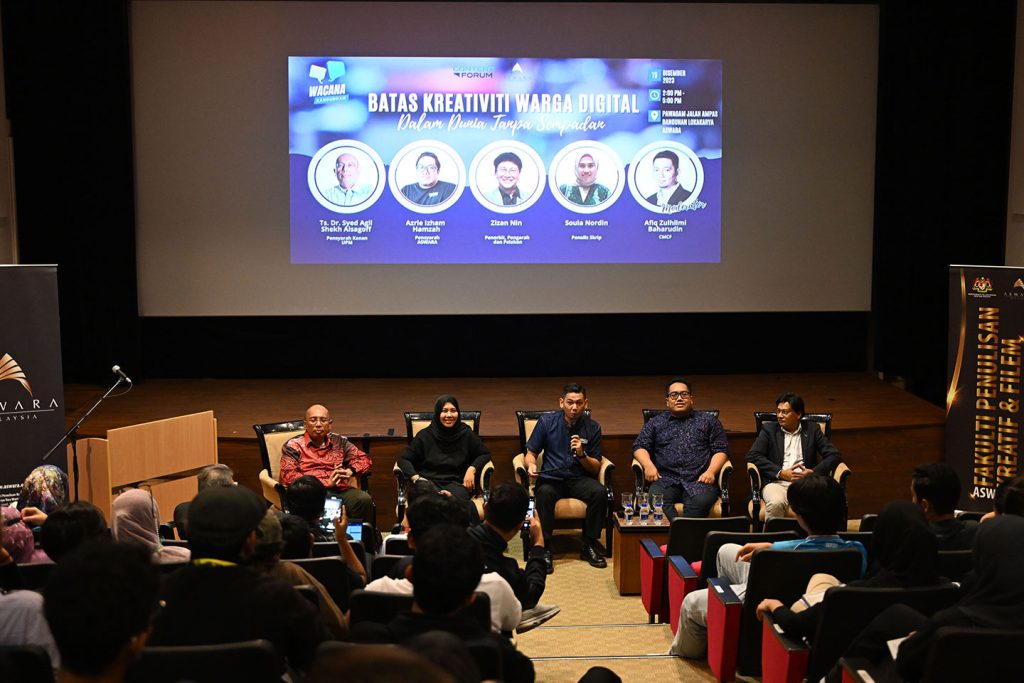KUALA LUMPUR, MALAYSIA — Creative freedom within the Malaysian film industry is evolving, pushing artistic boundaries and engaging audiences in diverse narratives. However, amidst this exploration, a consensus emerged during a recent industry forum titled “The Limits of Creativity In A World Without Borders,” hosted by the Content Forum and National Academy of Arts, Culture and Heritage, ASWARA.
The discussion, featuring a diverse panel of seasoned professionals including writers, directors, producers, educators, and film students, emphasized the crucial balance between creative freedom and responsibility in filmmaking. The panel included notable figures such as Mediha Mahmood, Chief Executive Officer of the Content Forum; Ts. Dr. Syed Agil Shekh Alsagoff, senior lecturer at Universiti Putra Malaysia (UPM); Azrie Izham Hamzah, lecturer at ASWARA; Zizan Nin, a multifaceted figure in the industry as a producer, director, and actor; and Soula Nordin, scriptwriter.
Dzul Karnain Abdullah, a lecturer from ASWARA and board member of TV AlHijrah, set the tone, underlining the need for self-regulation among both creators and audiences in the digital age. Reflecting on the evolution of creative mediums, Dzul stressed the responsibility of digital citizens to exercise self-control amid the abundance of readily available content. This responsibility, he emphasized, extends to contributing actively to a society free from harmful influences across generations.

Expanding on this, Mediha Mahmood, highlighted the Content Code as a valuable resource. “For us at the Content Forum, we greatly emphasize balance; allowing filmmakers creative freedom while ensuring audiences, especially children, are shielded from harmful content. We highly encourage self-regulation, in the hopes to reduce instances where filmmakers are left disappointed with the censorship of their work, to the point where they no longer recognize it,” she said in her speech.
Illustrating this need for balance, Dr. Syed emphasized the impracticality of sweeping bans on profanity without considering the contextual nuances in which such language is employed. He argued that such a rigid stance would be unrealistic, particularly in the realm of film, which inherently aims to depict stories in a realistic and creatively expressed manner. Dr Syed stressed the importance of directors exercising creativity to align their films with the guidelines established by the National Film Development Corporation Malaysia (FINAS) or the Content Forum, thereby ensuring a balance between artistic freedom and compliance with regulatory standards
Providing insights from a director’s standpoint, Zizan said that the audio-visual nature of film offers filmmakers a diverse set of techniques to bring a script to life on the screen. These include the subtle incorporation of metaphors, strategic use of cinematography, manipulation of lighting, and thoughtful selection of props. Zizan emphasized the importance of not always taking a direct approach in depicting scenes. As an example, he mentioned the use of a kiss to convey affection, noting that while such displays may be a cultural norm in other regions, particularly in Europe, it’s essential to recognize and respect cultural differences. He underscored the significance of mutual understanding, where diverse cultural perspectives coexist without judgment or blame.
Soula provided an example from her script for the film Angah, where a sensitive topic was portrayed without explicit scenes. “I don’t write explicit scenes, but even without me writing it that way, the female director’s (Eyra Rahman) creativity in handling such sensitive matters meant she could still deliver the message well,” she said.
Meanwhile, Azrie urged filmmakers to be mindful of their target audiences and how their work’s themes and messages will be perceived. “This advice particularly applies to film and writing students who often feel compelled to make stories excessively ‘deep.’ Instead, we should strive to shoot scenes in a way that resonates with audiences, playing with visuals to enhance understanding,” he said.
Azrie added that with the nature of social media, lengthier films are sometimes shared as bite-sized chunks, which can easily misconstrue the original message of the film. In this sense, audiences can practice self-regulation by viewing full versions of films and assessing the intended themes for themselves.
The overarching message from these insights is clear, as the industry pushes boundaries, a sense of responsibility and self-regulation ensures that films not only entertain but also educate and contribute to positive societal dialogues.










